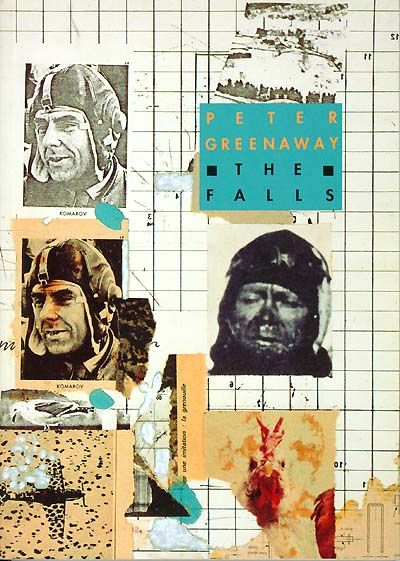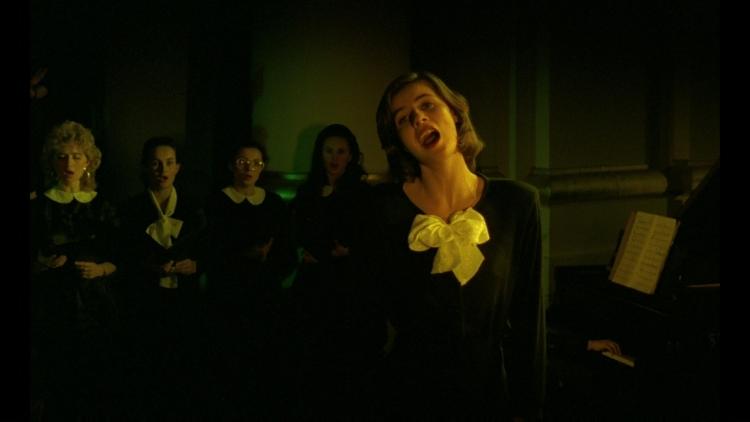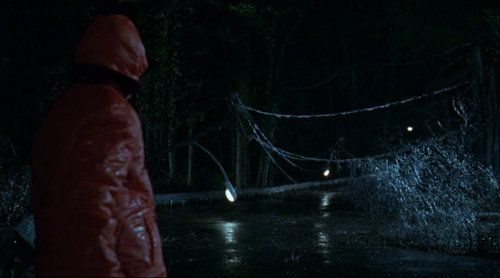![goldwing[1]](http://numerocinqmagazine.com/wp-content/uploads/2014/10/goldwing1.jpg)
Numéro Cinq at the Movies readers should recognize Julie Trimingham‘s name from one of our first entries when we featured her lovely, haunting triptych of films beauty crowds me, a pseudo-adaptation of the poems of Emily Dickinson.
In keeping with Numéro Cinq’s penchant for reflecting on the creative process, NC at the Movies is asking filmmakers we’ve featured to reflect on why they make movies, what compels them to tell the visual stories they tell. Presented with that question, Julie Trimingham came back to us with a triptych (she likes to work in threes) of articles that look at her relationship with film: “Rosebud,” “The Horror,” and “Raising Hell.” This month NC at the Movies features her first article, “Rosebud.”
Reading Trimingham’s reflections on film is for me like reading someone else’s love letters. It led me to reminiscing about my own film loves, and here, specifically, the moments that have made me gasp and filled me with wonder. We’d love to hear about your favourite film moments of wonder in the comments.
— R. W. Gray
.
Part 1: Rosebud
.
As a new mother, I used to dream of the apocalypse. B-movie stuff, but real enough to my sleeping self. The world on fire, thugs on the loose and armed to the hilt, bony-backed dogs on the prowl. I was always running with my infant son in my arms, trying to save him from whatever disaster impended. Waking life seemed much the same, with similar failure. The knowledge that despite my best efforts, the oceans are acidifying, the soil is dying, the aquifers are drying, all hell is breaking, and human idiocy and barbarism continue apace, that I cannot save the world for my son, almost crushed me. My fear of collapse zeroed in on my own body. Legs going numb. Tongue heavy. Short of breath. Heart too quick. When my palms turned itchy and bright red in a hysterical gesture of stigmata, I called a counselor; although she specializes in troubled children, she was the only such person I knew in town and I thought she might provide direction. Turns out, she sidelines in Jungian analysis for adults, and she was willing to take me on.
And it turns out that Jung is all about dreams, about decoding images projected from the subconscious. Dreams are films unspooled at the back of the mind; anxiety is a harshly lit breaking news broadcast in my frontal lobe: both are communications sent by far-flung outposts of my self. My analyst Sharon acts as translator with Jung’s Dreams Memories Reflections (which lies as yet unread on my nightstand), as an app for the subconscious.
The more I think about dreams, the more I think about the films I’ve watched and the films I’ve made, and how they have, in turn and in part, made me. Although my first film, about a young woman born with a tail, likely sprang full-formed from my twisty subconscious, later films have hints of external influence. I can draw a smudged line between Peter Greenaway’s The Falls, a strange pseudo-documentary about people who turn into birds after the apocalypse, and my own ficto-documentary about a singer who spreads her copper wings.

It’s been pointed out to me that I must like Bergman (I do) because one of my black and white films features a couple fighting as they drive home in the night rain. I’m the product of a mother who loves American Technicolor musicals, so how could I not want to shoot an imaginary plane-ful of synchronized stewardesses? But these are image-to-image, film-to-film correspondences, and I keep being drawn back to the idea that film might inspire or inform a psyche, a self.
As I suspect we all do, I carry inside myself a mash-up of images and scenes culled from movies I’ve watched. The clips that stick, the films that I am likely misremembering now as I work through these thoughts, tend to bend in the direction of wonder. And of brutality. Metabolized over years, these images have worked their way into my blood, bones and brain. They are spliced into an internally projected, constantly revised reel of my own dreams, memories and reflections, all of which then make their way into my own work, which in turn can be read as a waking dream.
Wonder, brutality. Is it as simple as the beauty and truth formulation? Wonder as beauty ratcheted up, as an experience so big and so deep that it becomes mysterious, miraculous? And brutality as the hardest kind of truth, the ugliest and most naked: of man stripped bare of humanity. Are these the things that take our breath away?
“Rosebud“ is the word made with Citizen Kane’s last breath; it is also the word that begins, that causes, that animates the film. That word is Kane’s alpha and omega, and the entire film is about wondering what that one word means. We are suspended for almost two hours in a state of unknowing, of being led by Orson Welles’ tracking shots in a spiral that leads to the center of Kane.

A bud, like a self, unfolds from the center. To be struck with Stendahl’s syndrome is to experience dizziness, to faint, to be overcome by beauty. That syndrome is the namesake for the man who wrote that beauty was la promesse du bonheur, he didn’t say it was happiness itself. A bud is a rose that has not yet bloomed: its beauty is the promise of a rose. The cook who lives next door to me makes a dessert of wild roses that grow by the sea: a candy glass made from rosewater syrup, a sweet foam whipped from the hips, all of it then scattered with petals. 13 Ways of Eating a Rose. And then the flower is gone, swallowed. All you’re left with is memory. Orson Welles, Rosebud on his lips, dies trying to name, to call up the memory and metaphor of his childhood, his happiness, his time of wonder.

I saw my first movie when I was six and was amazed to see versions of my self – the children in Small Change – writ large upon the screen. In François Truffaut‘s film, a toddler climbs onto the sill of an open window several stories up, entranced by a cat just out of reach. The toddler slips, plummets. The neighborhood gasps. The camera pans down, an agonizing moment of anticipating a smashed skull, blood on the sidewalk. But there the baby is, sitting up, laughing. A moment of astonishment, resilience and delight that I have held onto, now for decades. Escape to Witch Mountain was undoubtedly mediocre, but it was the first movie I watched from the back seat of the family station wagon at the drive in, and it has given me forever the image of a child levitating, saint-like, in a tree.

Frogs fall from the sky in P.T. Anderson‘s Magnolia. The artless photographer frames overlooked beauty in Patricia Rozema‘s I’ve Heard the Mermaids Singing. A woman wandering through Tivoli’s spectacular water gardens disappears into a fountain in Kenneth Anger’s Eaux d’Artifice. All of Maya Deren’s Meshes of the Afternoon. (A year-long stint as a volunteer at Anthology Film Archives on the Lower East Side of Manhattan imprinted me with classic experimental films). The loveliness of the wintered Ontario forest stops Julie Christie in her snowshoeing tracks in Sarah Polley‘s Away from Her. The heart-rending music in Krzysztof Kieslowski’s Double Life of Veronique and in Bleu is not so much soundtrack as character or catalyst.

The Ice Storm has a young teen so dreamy and astonished by life that he doesn’t even notice when the football is thrown to him during a game.
When I was in film school, we learned to edit on an old Steenbeck, a hulking machine operated with foot pedals and manually loaded reels. Film clips, the actual, physical strips of frames that constituted takes of each scene, hung from clothes pins in a bin. You’d work in a cramped room with the overhead fluorescents off, squinting at the crude backlit screen, cutting and taping frames together. Each bin was organized by act or scene. As I write this, I notice that I’m hanging these clips of childhood and mystery, of incomprehensible beauty, all together. The bin fairly glows.
But how quickly the sublime flips into something darker: Julie Christie’s character is lost in the forest because she’s losing her mind. As Weronika, the Polish double, solos and hits an impossibly high note, she collapses and dies, pang-ing the French Veronique with an ineffable sense of loss. The boy in Ang Lee‘s film will be electrocuted by a line felled in the ice storm at whose loveliness he has stopped to marvel.

I have become a believer in the notion that filmmaking is an act of orchestrating chance, of listening and serving, as much as it is a deliberate construction, and that something more than light and sound are imprinted on film stock.
I remember shooting “beauty crowds me” in the shower room of an old army barracks; the set was closed: it was just me, my (now ex-)husband/producer, a steadi-cam operator, and women in various states of nakedness. One woman drags another across the floor; one washes another’s back; the bathers move as if underwater. Occasionally they look straight into the camera. The viewer is complicit, implicated, acknowledged. Listening to Sarah MacLaughlin on a boombox, Carey, the camera op, pas-de-deuxed with Denise, the protagonist, as she made her way towards the shower, slowly shedding her clothes. Emily Dickinson’s short poem has absolutely nothing to do with bathing:
Beauty crowds me til I die
Beauty mercy have on me
If I should expire today
Let it be in sight of thee.
The words have always struck me as a prayer, a plea for wonder. My aim was to have Denise catch sight of some beauty that hovered out of frame, next to where you, the audience, might be. (Naked because it seems like that is the state of a soul when, like Whitman, it stands cool and composed before a million universes.) Between takes, the women would slip into jewel-toned bathrobes and hang out in the barracks common room with the crew. It was an enchantment: we all surrendered en masse to the music, to each other, to the poet speaking across time. When wrap was called, we emerged into a changed world: snow had been falling, and was now thick and softly blue in the twilight.

Somebody once said to me after watching the film, I don’t know where I just was, but I was there. There is something alive in the air, in the collective energy of cast and crew and story and moment, that is captured, then shared with the audience. I’ve often thought that film’s trick of transport is reason enough to call a crew together, to paint walls, to shop for props, to dress up and choreograph, to run lines, to fire up the lights and roll camera. The cumbersome apparatus of filmmaking – machinery, logistics, personnel, budget, schedule – finds its end in a beam of light. A beam of light through which you can pass your hand yet one that moves us. Sometimes we even fall in love with the world anew.
Experiences of wonder can open us up, make us bloom. Don’t ask me to explain, but I believe that it keeps the apocalypse at bay.
—Julie Trimingham
.
 Julie Trimingham was born in Montreal and raised semi-nomadically. She trained as a painter at Yale University and as a director at the Canadian Film Centre in Toronto. Her film work has screened at festivals and been broadcast internationally, and has won or been nominated for a number of awards. Julie taught screenwriting at the Vancouver Film School for several years; she has since focused exclusively on writing fiction. Her online journal, Notes from Elsewhere, features reportage from places real and imagined. Her first novel, Mockingbird, was published in 2013.
Julie Trimingham was born in Montreal and raised semi-nomadically. She trained as a painter at Yale University and as a director at the Canadian Film Centre in Toronto. Her film work has screened at festivals and been broadcast internationally, and has won or been nominated for a number of awards. Julie taught screenwriting at the Vancouver Film School for several years; she has since focused exclusively on writing fiction. Her online journal, Notes from Elsewhere, features reportage from places real and imagined. Her first novel, Mockingbird, was published in 2013.
‘
‘
.
.